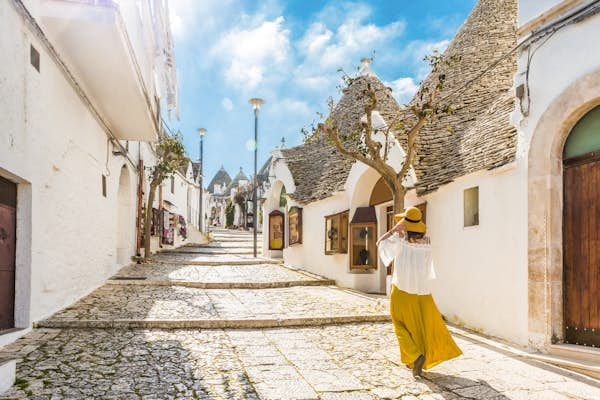
Puglia is a kaleidoscope of territories, ecosystems, and rhythms of life, hard for a single word to encompass. Some older Italians refer to the southern Italian region of Puglia as Le Puglie, meaning “many Puglia”, and while today there is no such thing as Le Puglie, when you visit you’ll realize why people still call it that.
Puglia’s 940km (584 miles) of coastline, which were once part of the Magna Graecia and harbored ancient Romans’ mighty flotillas, outlines what is known as the “boot heel” of Italy. In the past decade, some areas have made headlines for hosting flashy weddings and being celebrities’ summer escapes. However, much of the region remains a little-known historical, natural, and culinary gem. If you venture to some of its hundreds of towns, you will encounter an authentic southern Italian way of life filled with earthy flavors, sharp colors, and welcoming smiles.
Immerse yourself in the best experiences the world has to offer with our email newsletter delivered weekly into your inbox.  Cool down along Puglia’s coastline in the summer months © Ilias Katsouras jr / Getty Images
Cool down along Puglia’s coastline in the summer months © Ilias Katsouras jr / Getty Images
When to go to Puglia
Puglia gets hectic during July and August when most Italians get their mandatory summer vacations: hotels are pricey and book up months in advance, beaches are uncomfortably crowded, and it can get scorching hot, with some days heating up past 40°C (104°F). During this time, nightlife blooms. Clubs in the Salento area blast music until sunrise; music festivals such as Locus and Notte della Taranta bring in musicians from all around the world; and town squares fill to celebrate sagre di paese, the much-awaited yearly religious and food fairs.
Before and after the two central summer months, the region’s mild climate gives 25°C (77°F) days as early as April and into October, making it an ideal destination if you are looking for peace, charming towns, and empty crystal-clear waters. This is also an excellent time to venture into the green countryside and taste some of the region’s wine and olive oil. Hotels are more affordable, and the quality of food and services improve, freed from the high-season pressure.
You might find yourself without many fellow travelers from November to March. Some restaurants and hotels close for the season, and public services wind down. Still, this might be the best time to sit at a neighborhood cafe, drink an espresso and chat with pugliesi. Many of them will point you to their favorite local restaurant and take the time to explain why their towns’ panzerotto (fried pastry), tiedda (Bari’s famous rice potatoes and mussels dish), or grape variety, are undoubtedly, and incontestably, the best.
Where to go in Puglia
If you reach Puglia by car from the north of the country, once you cross the region’s border, do not think, “Ah, we have finally arrived.” You might still have 400km (250 miles) – almost the distance between Paris and Amsterdam – to drive if you aim to reach its deep south in one go. On the way there, you’ll cross its four main subregions.
 The Promontorio del Gargano has white limestone cliffs that tower over the sea © Atlantide Phototravel / Getty Images
The Promontorio del Gargano has white limestone cliffs that tower over the sea © Atlantide Phototravel / Getty Images
Gargano peninsula
Promontorio del Gargano, with its mountains passing 1000m (3280ft) above sea level, towers over the rest of the region. Hidden in this mountainous land, Foresta Umbra, an ancient forest of centuries-old beech trees, offers a variety of hiking opportunities. On top of the peninsula sits Monte Sant’Angelo, a Unesco World Heritage Site and a famous pilgrimage site to St Michael the Archangel sanctuary, built inside an old karst cave.
If you are into panoramic and curvy roads, don’t miss the drive between Peschici and Mattinata. You might notice some old wooden structures leaning forward into the sea along the drive. Those are trabucchi, traditional fishing structures of the area. While some lay abandoned, others have been refurbished to host some of the coolest restaurants in the area. At Al Trabucco da Mimì in Peschici, you can sip a glass of d’Araprì, one of Puglia’s best sparkling wines, sitting on the old wooden structure while a band of jazz musicians plays as the sun drops down below the horizon.
 Castel del Monte is one of Puglia’s unmissable places to go © Vincenzo De Palo PHOTO / Getty Images
Castel del Monte is one of Puglia’s unmissable places to go © Vincenzo De Palo PHOTO / Getty Images
Alta Murgia
Where the Apennine mountains end, the hilly Alta Murgia begins. This stony land is one of Italy’s last wild steppes. I grew up in this territory at Biomasseria Lama di Luna, my family’s organic masseria, one of the typical farmhouses open to guests that delineate the landscape. All around, a dozen towns hide precious city centers, stunning but austere cathedrals – Trani’s cannot be missed – and castles. With its octagonal shapes, Castel del Monte, a medieval castle and a Unesco World Heritage Site, is a must-see wonder: make sure you get a guide that will tell you more about its story and legends.
Puglia produces about 50% of Italy’s olive oil, and the town of Andria is number one when it comes to extra virgin olive oil. Check out Le 4 Contrade in the countryside of Andria for a walk in the olive fields and a tasting with Sebastiano and Valeria, a young couple that makes stellar extra virgin olive oil. Then, for a glass of Nero di Troia (a local variety of red wine), visit the Morasinsi winery in Minervino and meet Sveva, who will tell you all about regenerative agriculture. Stop for a meal at Antichi Sapori in Montegrosso and Mezzapagnotta in Ruvo, both restaurants that have made local recipes based on foraging from within Alta Murgia National Park (make sure you book well in advance).
Valle d’Itria
Drive south past Bari, the region’s capital, and you’ll hit Valle d’Itria. You’ll be welcomed by a continuous forest of monumental olive trees, so twisted by their age that they seem to be holding the weight of the sky with their branches. All around, white towns pop out on various hilltops. With its stunning views, Ostuni, known as the “White City,” gets the credit for the whitest. At the same time, Alberobello, another of Puglia’s Unesco World Heritage Sites, will leave you speechless with its trulli, traditional stone houses with cone-shaped roofs.
If you stop by Cisternino, an old medieval town, go to the city’s square, enter one of the many butchers, and select your set of bombette, “little bombs” of sliced meat rolled and stuffed with cheese and herbs, that they will cook for you on the grill. In Polignano a Mare, look out over one of its dramatic cliffside terraces and maybe stop for a tuna tartare and burrata sandwich at Pescaria. If you fancy sleeping in a masseria, Borgo San Marco, Il Frantoio and Masseria Cervarolo are worth considering.
 Lecce is known for its beautiful architecture © Piero M. Bianchi / Getty Images
Lecce is known for its beautiful architecture © Piero M. Bianchi / Getty Images
Salento
As you reach the tip of the region, you enter Salento, the easternmost part of Italy. Its capital, Lecce, is known as the “Florence of the South” for its stunning baroque architecture adorning its city center and the myriad noble palaces. Each town has its historic city center that brightens up during summer nights for the yearly religious festivals and food fairs. But besides its history, what makes Salento unique, is its crystal clear waters you can find all along its coastline: with Torre Sant’Andrea, Porto Cesareo, Castro, Santa Maria di Leuca, Gallipoli, and Porto Selvaggio, you’ll have plenty of choice for where to stop for a swim, or, maybe, rent a little boat to cruise along the rocky coastline for the day.
While for the past ten years, the region has been devastated by a foreign bacteria that has killed most of the territory’s olive trees – those gray trees you’ll see along the road are all dead – a pocket of young farmers is working to revive the territory. Tàccaru, for example, is processing the beautiful century-old dead olive wood to replant young resistant olive trees. Wineries are pitching in, too, to preserve the area’s old vineyards. At Castello Frisari in Scorrano and Castel di Salve in Depressa, young winemakers are eager to let you try the traditional Primitivo and Negramaro wines. Between glasses of wine, if you get hungry, check out La Taverna del Porto in Tricase and Farmacia dei Sani in Ruffano.
How long to spend in Puglia
Puglia is no day-trip destination. Much of the itinerary choice depends on the time of the year and what you seek. I would give Puglia a week to pass through its four main areas, savor what the region offers, and take the time to understand its rhythm.
But suppose you only have a weekend to spare. In that case, land in Bari in the morning, have a focaccia barese slice at Panificio Fiore, and accompany it with a cold Peroni beer while checking out the Basilica di San Nicola and the historic city center. Then drive to visit Castel del Monte, and sleep in a masseria in Valle d’Itria. The day after, visit Alberobello and a coastal city such as Polignano a Mare or Monopoli, and, if the weather and season allow for it, swim before returning home.
If you can add a couple more days to the trip, consider adding a night in the Alta Murgia area to enjoy a dinner in Minervino Murge. After the day in Valle d’Itria, check out Lecce and its baroque architecture.
 Having your own car is the best way to explore Puglia, but you’ll see cyclists and biking groups too © Andrea Pistolesi / Getty Images
Having your own car is the best way to explore Puglia, but you’ll see cyclists and biking groups too © Andrea Pistolesi / Getty Images
How to get in and around Puglia
Two main airports, in Bari and Brindisi, are the main gateways to the region. High-speed trains from Rome, Naples, and Milan reach Puglia with a reasonable frequency. Brindisi and Bari are also connected with ferry boats to Greece, Croatia, and Albania. But, honestly, if you want to experience Puglia, you might want to rent a car once you’re there.
Even if you plan to stay for a weekend, renting a car will allow you to visit different places on the same day without relying on the often unreliable public transportation system.
Several tour operators organize biking group trips along the region. During spring and autumn, the less hot times of the year, it’s common to meet groups of adventurers that cycle along the way.
Top things to do in Puglia
Visit Castel del Monte. Then reach out to Antonella Urbano, the horseback riding teacher who taught me how to ride when I was a kid. She will take you for a slow late afternoon horseback ride immersed in the Alta Murgia National Park. The perfume of wild herbs and flowers will surround you, with, in the distance, the octagonal castle outlining the horizon.
My favorite thing to do in Puglia
Take the day to drive along the coastal road that connects Otranto and Santa Maria di Leuca in Salento. On the way, stop in one of the rocky bays with access to the sea for a swim, maybe at Grotta Zinzulusa in Castro. Then, have a caffè leccese, an espresso shot with ice and a finger of almond syrup, with a sweet pasticciotto at Martinucci. Then, drive some more until you reach Tricase Porto for another dip in the clean port waters. To end the day, walk a few stairs up to Caffe d’Oltremare for a glass of Negroamaro wine, a handful of taralli and pickled olives. Sit on the open terrace overlooking the sea and let the blue Mediterranean calm your eyes and reward you for taking the time to slow down.
How much money do I need in Puglia?
Puglia is a generally good-value destination compared to other parts of Italy. Regarding food and drinks, you get a high quality for fair prices. Puglia is known as “the garden of Italy”, meaning that many fruits and vegetables are cultivated locally – flavors in the meals will reflect that. You can pay for coffee with a €1 coin and a sandwich with two more. However, be on the lookout during July and August in more popular destinations such as Gallipoli or Polignano a Mare, when suddenly, instead of €2 for a Peroni beer, it can cost three times the off-season price.
A guide to daily costs in Puglia
Hostel room: around €50
Basic room for two: between €80–100
Self-catering apartment (including Airbnb): from €120
Public transport ticket: €1 for a single ride, €2.50 for a day ticket
Coffee: €1
Panzerotto: €1.50
Sandwich at a bakery: €3
Dinner for two with a bottle of local wine: €70
Beer/pint at the bar: €2



